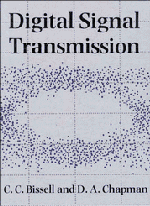Book contents
- Frontmatter
- Contents
- Preface
- 1 Introduction
- PART 1 MODELS
- PART 2 PROCESSES
- 4 Pulses for digital transmission
- 5 Line codes
- 6 Channel codes
- PART 3 DIGITAL TRANSMISSION OVER THE PUBLIC SWITCHED TELEPHONE NETWORK
- Appendix A Fourier series and transforms
- Appendix B Convolution
- Appendix C Modelling applications of spreadsheets
- Answers to numerical exercises
- References
- Index
5 - Line codes
from PART 2 - PROCESSES
Published online by Cambridge University Press: 05 June 2012
- Frontmatter
- Contents
- Preface
- 1 Introduction
- PART 1 MODELS
- PART 2 PROCESSES
- 4 Pulses for digital transmission
- 5 Line codes
- 6 Channel codes
- PART 3 DIGITAL TRANSMISSION OVER THE PUBLIC SWITCHED TELEPHONE NETWORK
- Appendix A Fourier series and transforms
- Appendix B Convolution
- Appendix C Modelling applications of spreadsheets
- Answers to numerical exercises
- References
- Index
Summary
Introduction
In the layered model introduced earlier line coding is immediately above pulse generation and below channel coding. The input from the channel coding layer is an arbitrary binary sequence plus a timing waveform, and the output to the pulse generation layer can be thought of as a (structured) sequence of impulses.
In a real system line coding is generally very closely connected with pulse generation and it would often not be possible to separate completely the electronic circuits performing line coding from those generating the pulses. The close connection between line codes and pulse generation is reflected in the presentation in this chapter, where line coded waveforms will be illustrated (assuming, generally, rectangular baseband pulses), rather than the sequences of impulses which form the conceptual output of the line code layer.
Although there is a theoretical background to the analysis of line codes (some of which is discussed here), in practice the evolution of line codes has involved a large element of pragmatism. New line codes have often been designed for use in specific systems, with features to combat particular problems in those systems.
Most line codes have three major functions. First, they allow a baseband signal to be conveyed over a channel with d.c. blocking. This is achieved by ensuring that the coded data does not build up short-term d.c. offsets. In the frequency-domain it is necessary for the spectrum of the coded data to fall-off to zero at d.c: it is not sufficient to ensure that the coded data has no d.c. component.
- Type
- Chapter
- Information
- Digital Signal Transmission , pp. 149 - 191Publisher: Cambridge University PressPrint publication year: 1992



